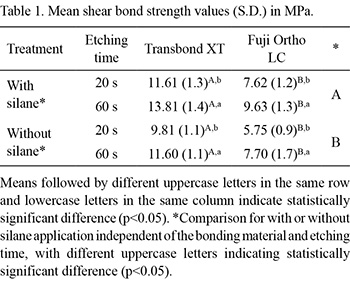The purpose of this study was to evaluate the bond strength of metallic orthodontic brackets to feldspathic ceramic with different etching times, bonding materials and with or without silane application. Cylinders of feldspathic ceramic were etched with 10% hydrofluoric acid for 20 or 60 s. For each etching time, half of the cylinders received two layers of silane. Metallic brackets were bonded to the cylinders using Transbond XT (3M Unitek) or Fuji Ortho LC (GC). Light-activation was carried out with total exposure time of 40 s using UltraLume 5. Shear bond strength testing was performed after 24 h storage. Data were submitted to three-way ANOVA and Tukey's test (α=0.05). The adhesive remnant index (ARI) was used to evaluate the amount of adhesive remaining on the ceramic surface at ×8 magnification. Specimens etched for 60 s had significantly higher bond strength compared with 20 s. The application of silane was efficient in increasing the shear bond strength between ceramic and both fixed materials. Transbond XT showed significantly higher (p<0.05) bond strength than Fuji Orth LC. There wasa predominance of ARI score 0 (clean ceramic failure surface) for all groups, with an increase in scores 1, 2 and 3 (adhesive material increasingly present on ceramic failure aspect) for the 60-s etching time. In conclusion, 60-s etching time, silane and Transbond XT improved significantly the shear bond strength of brackets to ceramic.
orthodontic bracket; ceramic; silane; acid etching


